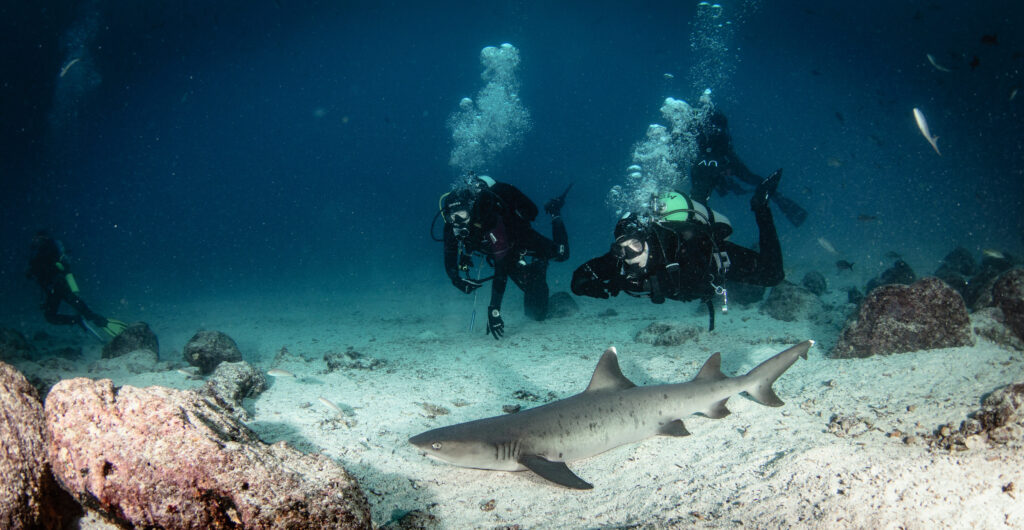What is Panic when Scuba Diving?

Panic in scuba diving refers to a sudden and overwhelming feeling of fear or anxiety that can severely impair a diver’s ability to think clearly and act appropriately. It is a critical issue in the sport because it can lead to dangerous situations underwater, where the margin for error is slim. Understanding panic is crucial for divers to ensure their safety and the safety of others. This entry examines the causes, symptoms, consequences, prevention strategies, and management techniques related to panic in scuba diving.
What is Cyanosis?

Cyanosis refers to a bluish discoloration of the skin and mucous membranes caused by an insufficient level of oxygen in the blood. This condition can signal underlying health issues, particularly those related to respiratory and circulatory systems. In scuba diving, cyanosis is a critical indicator that a diver might be experiencing hypoxia, a dangerous reduction in oxygen levels. Recognizing and understanding cyanosis is vital for ensuring diver safety, as it can be a precursor to more severe conditions if not promptly addressed.
What is Pounds Per Square Inch (PSI)?

Pounds per square inch (PSI) is a unit of pressure widely used in various fields, including scuba diving. Understanding PSI is crucial for divers because it directly relates to the equipment they use and their safety underwater. In scuba diving, PSI measures the pressure exerted by gas within a scuba tank, which is essential for breathing underwater. This unit helps divers know how much air they have left in their tanks, enabling them to plan their dives and avoid running out of air while submerged.
What is Professional Diving?

Professional diving encompasses a range of underwater activities performed by individuals trained and certified to work in various underwater environments. These divers are equipped with specialized skills and equipment to carry out tasks that support industries such as commercial oil and gas, scientific research, military operations, and public safety. The importance of professional diving lies in its contribution to the economy, scientific discoveries, and public safety operations, making it an indispensable occupation with a rich history and evolving technology.
What is Heliox?

Heliox is a breathing gas mixture composed of helium and oxygen, widely used in deep-sea diving due to its unique properties that improve safety and performance under extreme conditions. Unlike standard air, which consists of approximately 78% nitrogen and 21% oxygen, Heliox replaces the nitrogen with helium. This substitution is crucial in mitigating the adverse effects of nitrogen narcosis and oxygen toxicity that divers can experience at greater depths. Heliox has been a game-changer for technical and commercial divers, enabling them to work and explore at depths that would otherwise be highly hazardous.
What is Pressure?

Pressure is a fundamental concept in physics, defined as the force exerted per unit area. In the context of scuba diving, understanding pressure and its effects is crucial for safety and efficiency. Pressure plays a pivotal role in determining how divers experience the underwater environment, affecting everything from breathing to buoyancy. As divers descend into the water, the pressure increases, impacting both their equipment and bodies in significant ways. This article will discuss the principles of pressure, its effects on the human body, the health risks associated with changes in pressure, techniques for managing these changes, and the equipment designed to withstand them.
What is Rapture of the Deep?

Rapture of the Deep, commonly known as nitrogen narcosis, is a condition experienced by scuba divers at significant depths. This phenomenon, resulting from the increased partial pressure of nitrogen when diving, can lead to a range of symptoms that affect cognitive and motor functions. Understanding Rapture of the Deep is crucial for divers to ensure safe practices and avoid potentially hazardous situations underwater.
What is Vertigo?

Vertigo, a sensation of spinning or dizziness, can significantly impact one’s sense of balance and orientation. In the context of scuba diving, this condition becomes particularly relevant and potentially hazardous. Divers who experience vertigo underwater may struggle with maintaining their equilibrium, which can lead to disorientation and dangerous situations. This article delves into the causes, impacts, diagnosis, prevention, and management of vertigo specifically for scuba divers.
What is Equalization when Scuba Diving?

Equalization is a vital process for scuba divers, referring to the act of balancing the pressure of a gas-filled space with the surrounding or ambient pressure. This technique is essential in counterbalancing the increase in water pressure as divers descend and ascend, ensuring a safe and comfortable diving experience.
What is a Wet Pot?

A Wet Pot is a specialized water-filled hyperbaric chamber used predominantly in experimental work, training, and as a transfer chamber in saturation diving systems. These chambers play a crucial role in the field of hyperbaric operations and scuba diving by providing a controlled environment for divers and researchers. In training scenarios, Wet Pots simulate underwater conditions, allowing divers to practice and prepare for real-life situations. In experimental contexts, they enable scientists to conduct research on the effects of pressure and gases on the human body and various materials. Furthermore, Wet Pots serve as transfer chambers in saturation systems, where they facilitate the safe removal and handling of wet equipment after deep dives. Their versatility and utility make Wet Pots an essential component of modern diving and hyperbaric practices.
